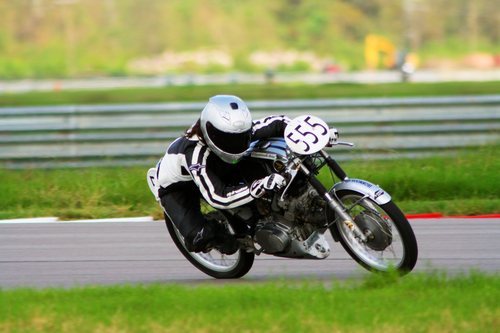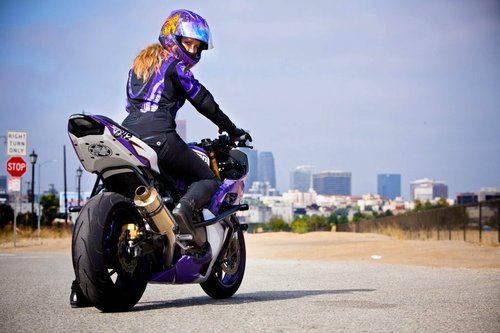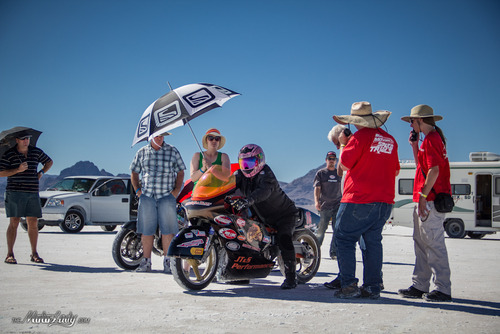
Eight decades of rumbling engines, two-wheel travel, exhaust smoke, and total badassery. Gloria Tramontin Struck has been blazing trails in the world of motorcycles since 1940 as one of the original members of the Motor Maids.

Anonymous sent me this message-
“I’ve been in love with bikes ever since my Dad put me on the back of his ‘79 Triumph Bonneville as a little girl, and I just met my lifelong goal of getting a license. Although I’ve ridden on the back plenty, I have no experience riding myself (except for the course). A great deal on a Honda Shadow Spirit 750 has come my way and I want to jump on it, but definitely have beginner jitters. What advice would you give a new rider looking to gain confidence and get comfortable? Love your blog!”
Hello Anon! Last time I gave advice about what type of bike was or was not (in my opinion) good for a reader, it caused a big tizzy. For that reason, I asked a couple notable motoladies to chime in too!

Stacie B. London, Founder/President of East Side Moto Babes and Vintage Motorcycle Racer-
Just go for it. Be careful, but dont doubt yourself. Follow your gut and don’t do anything that does not feel comfortable, but also have confidence that things take time and practice.

Leah (Stunts) Petersen, co-owner of StuntBums and Professional Stunt Rider-
Great to hear you took the safety course – that is something I always recommend to new riders. Personally I got comfortable with little drills I made for myself – starting,stopping, turning tight circles, etc. I would practice them in low-traffic areas and slowly add more advanced stuff. Even if it seems boring or beneath you – it pays off in the end. It’s all about training the muscles to remember everything that goes into riding. If something specific scares you, break it down to the basics and master each component, then the big picture should be easy!
From there, take it slow, know your limits and don’t be ashamed to stop and take a breather if you need to collect yourself.

Christine Parsley, Ecommerce Marketing and Product Manager at Cycle Gear and holder of two AMA land speed records at BUB motorcycle speed trials this year.
Don’t quit learning! There are lots of courses out there for different levels of riders. There are classes for people who are through their MSF licensing course but still want to develop their riding skills.
Gear up, every time you get on a bike. Get a decent helmet, not a used one. They don’t have to be expensive. A modestly priced helmet that fits will protect your melon much better than a poorly fitting one at twice the price. Get fitted for a helmet by someone who knows how. dealerships, moto gear shops, online retailers with good measuring/fitting instructions and a good return policy are all your friends.
Also get yourself boots, gloves, abrasion AND impact protection. Again, options are out there for gear at all price points.
I’m not going to tell you that a 750 is too much bike for a first moto. Some people might. I’ve seen folks with a bigger bike for a “first” and many who have worked their way up.
Listen to your gut instincts Take it easy on the throttle for a while, whatever bike you end up with, there’s going to be a while before you’re comfortable. Ride within your skillset. Start with short rides and work your way up to more saddle time.
Also remember that the moto industry has been hurting for a while and the economy has been bad. Motorcycles are a luxury for many and when things get tough, people start selling off their toys. If you decide not to take the deal on this bike, there’s always another one. It’s a buyers market for used motos and you can find some amazing deals with a little patience. If you decide you want to start out on a smaller bike, they are plentiful and not too expensive.

And my opinion?
When I was picking out my first bike, I was limited by cost before anything else. Size, yes… I didn’t want to get something too tall or heavy for me. I ended up with a 1980 Yamaha Maxim 650. A supposed 70 HP inline four, 550lb motorcycle that was honestly kind of a beast. Crappy brakes, not the best handling, horrible t-rex bars that were uncomfortable. But I loved that thing. And you know what? Between it being borderline too big for me as a first bike and breaking down all the time… I learned to manage a motorcycle more than a lot of new riders do. I respected that motorcycle for the weight it carried- if I dropped it on my leg wrong I could bust my bones. But I learned to work on it, I learned to take my time. Now when I ride modern bikes with good brakes that weigh in below 500lbs I almost laugh at how easy it seems in comparison.
That being said, don’t pass up something you want because you’re a little nervous. It’s good you feel that way, it means you respect the gravity of the situation. What the other ladies said rings true- take your time, don’t worry about looking silly. Practice, practice, practice. I can’t tell you how many times I’ve practiced stopping, slow tight maneuvers and the like.
Silly mistakes happen to all motorcyclists, I promise. Don’t worry about them too much ahead of time. You can read about my recent fumble when I dropped my bike in this article.
◙
Posted on October 19, 2012 in Blog, Motorcycles, News & Features by Alicia Mariah Elfving
Great post but it has to be said, all this advice is great regardless of gender. My advice to new riders is get something you can ride and then make sure you get out and ride it. If you ride with buddies, don’t try and keep up. If they’re good buddies, they will match your pace or wait at waypoints. And finally, keep learning and training.
That’s great advice. There are some very good ‘stay upright’ motorcycle courses available. They are excellent and all riders should do one. Your attitude when riding is very important and if you learn to anticipate potential danger before it happens you will be safer and happier. Those courses also teach things like counter steering and how/when to brake and picking ‘lines’ in corners etc which are all skills that every rider ought to learn about.
I generally advise people start with smaller and lighter bikes. My sweetie started on a Ninja 250 and was very glad she did (and it was a surprisingly fun bike in twisty roads.)
Get “Ride LIke A Pro” to see the techniques and drills you can use to learn on any bike. Definitely practice in a safe area until the controls become second nature. This will allow you to focus on the situation surrounding you instead of the best (or most appropriate) use of the controls.
I personally recommend starting on a small, light standard (naked) bike regardless of gender, size or ability. I think having to manage a heavy or big bike along with the other stuff you need to learn is unnecessary and riskier. It’s obviously doable but less critical than the other stuff you need (and should) learn first. Once you have your skills at a decent enough level, learning to handle big and/or heavy bikes is less of an ordeal. Most people have ridden BMX, mountain, hybrid or comfort bikes and a standard bike has similar ergonomics. Whereas sportbikes and cruisers do not and that will have some impact since you have to acclimate to a different stance.
Another suggestion is renting a small dirtbike (like the Honda CRF110F) and learning off-road (or on-road). It’s relatively cheap, you’re in a safe area, those bikes are built to take abuse and you avoid having to buy a bike you only need for 3-6 months. If you have a friend that has a bike they’re willing to let you use to practice, even better.
An Ounce of SAFETY is worth a pound of RISKS. I love this post..